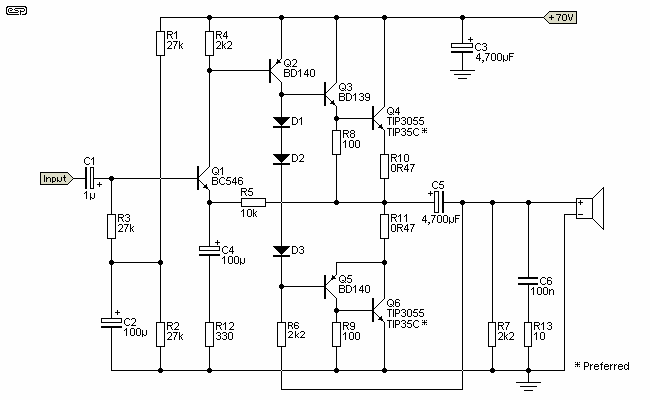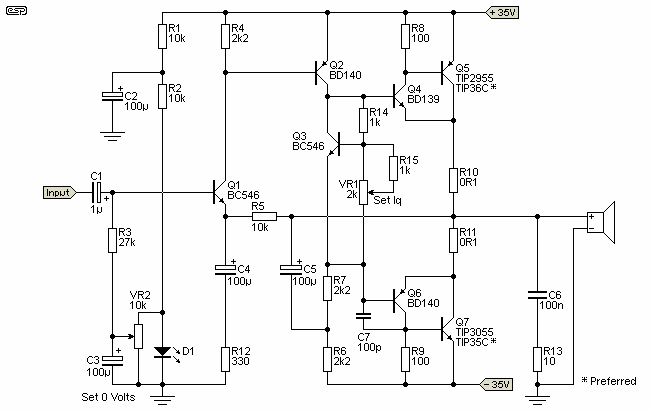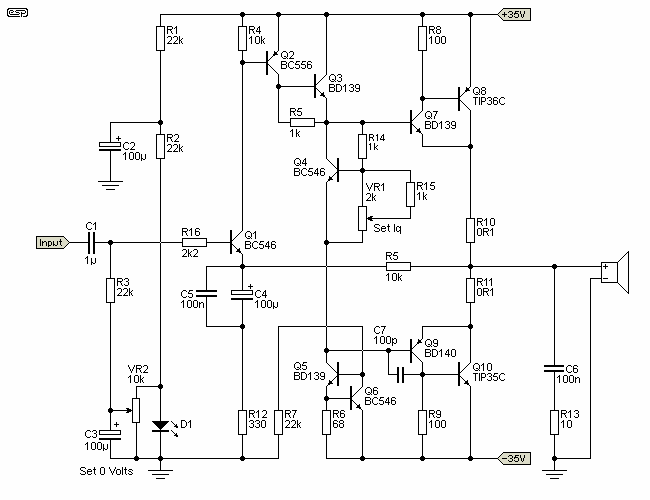

|
| Elliott Sound Products | Project 12 |
Note: - The amplifier shown here was previously incorrectly referred to as 'El-Cheapo'. Thanks to a reader who had a copy of the original 1964 article, it was immediately obvious that my recollection was flawed in the extreme. El-Cheapo was nothing like the circuit here, and is now available as Project 12A. The amplifier design(s) here have been preserved.
"Semi-Original Design" - What is that supposed to mean? After discovering the truth about El-Cheapo, I realised that the designs here were something of a mixture of various older designs that I had come across over the years. The exact details are long lost.
The first version of the amp shown here uses a single power supply and capacitor coupled speaker. It also uses quasi-complementary symmetry for the output stage. Note the really sneaky way the Class-A driver amp's collector load is bootstrapped!
For those younger than I who have no idea what I'm talking about, quasi-complementary symmetry was a scheme used in the days when PNP power transistors were expensive and useless. If you wanted any sort of voltage and current rating, you had to use NPN devices. The quasi-complementary output stage used a (discrete) Darlington for the positive side, and a complementary pair for the negative (i.e. a PNP driver coupled to an NPN power transistor). Some very highly regarded amplifiers used this scheme, and it is not 'inherently inferior' as some might claim.
Figure 1 shows the circuit. A major change from all of the designs from that era is the speaker coupling capacitor - 1000μF (for a -3dB of 20Hz and a 8 Ohm load) was the most common value. This is too small, and 4,700μF is a great deal better. You can use an even bigger cap, but that would defeat the purpose since the amp would no longer be cheap. Besides that, it still has a single supply, and such amps are not generally well considered by anyone these days. The objections are a mixture of fact and fantasy - electrolytic caps subjected to high currents do eventually 'dry out' and lose capacitance, but claims of distortion, high frequency loss and other objections are usually unfounded - provided the cap is of adequate value.
The most notable difference between this amp and more modern versions is the fact that there is no long-tailed pair (LTP) for the front end. Feedback is applied to the emitter of the input transistor, and works in current mode - hence 'current feedback'. This is possibly contentious - there are several interpretations of the term 'current feedback', and not everyone agrees. In this case, the emitter circuit of a transistor is inherently very low impedance, so is influenced by current. That the current is derived from a voltage is of little consequence, because this is the case for nearly all feedback circuits.
A small modification has been made since this article was published - the base-emitter resistor for the voltage amplifier stage (Q2 in Figures 1 and 2) has been reduced from 10k to 2.2k and if you wish to experiment you may wish to reduce it further. A high value resistor in this position can adversely affect the slew rate because the transistor cannot switch off very quickly, but a simulation shows little difference. I expect that real life may be a little less forgiving though.
One thing you will find is that the voltage at the output will have a significant DC component when no speaker is connected. This is because the output is used to bootstrap the collector load of Q2, so without a speaker connected you'll see about 16V at the output. This may seem disconcerting, but it falls close to zero when the speaker is connected, and the offset current is about 7mA (8Ω) or 15mA (4Ω). This is equivalent to a DC offset of about 56mV, and represents a voicecoil dissipation of less than 1mW.

Figure 1 - Basic Amplifier Schematic
Almost all amps of the era from which this circuit originated used the 2N3055 - this was the pre-eminent power transistor (NPN of course), and there were no vaguely equivalent PNP devices for less than about 5 times the price, and even these were highly inferior. As a result, the quasi-complementary output was very common, until decent PNP power devices became more readily available. Immediately, just about everyone started using NPN and PNP Darlington coupled devices for the output stages (as shown for Q3 and Q4) - the funny part is that it was demonstrated back in the mid 1970's that the full Darlington connection actually sounds (or at least measures) worse than quasi-complementary stages. Is not progress a wonderful thing?
So, I got to thinking about this (as I have done many times, but it never went anywhere), since the input stage of a current feedback amp is not subject to the phase problems of the long tailed pair, and amps with this input stage tend to be inherently stable. They do have a problem with DC offset (which was not a problem with capacitor coupled speakers), but this can be solved with a DC servo circuit using an opamp, or a simple bias offset can be used.
As shown, the gain for audio frequencies is 31 (30dB), which means an input sensitivity of 700mV for an output of 60W (near enough to 0dBm). This remains unchanged for the variations following.
Note: Diodes D1-D3 should be 1N4004 or similar, and must be mounted so they are in thermal contact with the heatsink. If not, thermal stability will be poor, leading to potentially excessive current when the output transistors are hot.
Note that this article is a 'theoretical study', in that the amp described has been simulated but not built. The output stage is completely conventional, using the complementary pair configuration which is now the standard for all designers who have ever read anything by Douglas Self, Matti Otala, John Linsley Hood, myself or a myriad of others who have all denounced the Darlington as an inferior output stage in every significant respect.
Figure 2 shows the circuit of the amp in basic form, remaining fairly true to the original concept except for the dual power supply, direct-coupled speaker and a bias servo allowing lower value emitter resistors for the output stage. A DC offset control is mandatory here, and the LED is used as a stable voltage reference for the offset voltage. With a solid power supply (such as that described for the 60W Power Amp), this amp is perfectly capable of 60 to 70W into 8 Ohms. Additional output transistors can be connected in parallel to allow for 4 Ohm loads, where 100W should be readily achieved. With the suggested replacement output devices (TIP35C/36C) parallel devices aren't needed.

Figure 2 - The "New Improved" Version
The Class-A driver is perfectly normal, but can be improved by using a bootstrapped buffer transistor, and the use of a current sink load for the Class-A driver will improve gain and linearity. As shown, the Class-A driver load is still a bootstrap circuit. With a sufficiently large capacitor to allow for the lowest frequencies, good linearity is obtained, with the driver current remaining effectively constant for the full swing of the amp.
Even without the buffer on the Class-A amp stage, a simulation (admittedly using 'ideal' transistors) of the input and Class-A stage shows a gain of about 100dB, or 100,000 with a current sink of 100k Ohms. This is approximately what can be expected from the bootstrap circuit due to the losses in the output stage. The bias servo transistor (Q3) must be in thermal contact with one of the driver transistors (Q4 or Q6).
A useful increase in gain may be achieved by increasing the current through Q1, by reducing the value of R4. There is a problem with this however, since the voltage across R5 becomes excessive, raising the input DC voltage on the base of Q1. One can reduce the value of R5 (the feedback resistor) but then the required capacitance of C4 becomes too high to be sensible because R12 must be reduced for the same audio gain.
Figure 3 shows all the additional improvements possible while still retaining the input stage, and a simulation indicates that the open-loop gain of this configuration is over 150dB (or 30 Million) open loop - this is likely to be somewhat optimistic, but is a good indicator of the available gain one can achieve without the current mirrors and other accoutrements generally found in typical input circuits. With a gain as high as this, there is enough feedback for anyone - without getting more complex.
The input capacitor has been changed to a polyester (or similar) and with 1μF has a lower -3dB frequency of 7Hz. This may be made larger if your speakers can go lower than that. One thing you cannot do with this input stage is direct couple from a preamp. The voltage on the base of Q1 will be about 1.3V for 0 Volts at the speaker output. If the input were grounded, then there will be -1.3V across the speakers - this is generally considered to be a bad idea. It is only 200mW for an 8 Ohm load, but it should be avoided.
The 100nF capacitor (C5) in parallel with C4 in the feedback network will make absolutely no difference whatsoever, but some people think that it's necessary or somehow changes the sound of the amp. It doesn't, but if it makes you feel happier to have it there then be my guest.
Speaking of feedback - because the input stage creates an inherently stable amp, there is no reason to expect that TIM (Transient Intermodulation Distortion) will be a problem (assuming it actually ever existed in a real amplifier operated under normal conditions), since feedback is simply applied to the emitter of the input amp, and little or no frequency "compensation" is needed. This is an area where some experimentation is needed, and it might be necessary to connect a low value (47pF ?) capacitor between collector and base of Q2 - it was not needed in the original, but this configuration has vastly more gain and today's transistors are a great deal faster.

Figure 3 - The 'Even-Newer More-Improved' Version
I tend to like Figure 2, since it appeals to my KIS approach (Keep It Simple) towards all things electronic, while still maintaining a sensible attitude towards providing adequate feedback and other techniques to minimise distortion. Having said that, Figure 3 is probably going to be the better amp overall, since it will have better linearity before feedback is applied.
The astute reader will realise by now that the entire Class-A driver and output circuits are virtually identical to many of the high-end amp designs one can find on the Web and in magazines (etc). The only bit missing is the long tailed pair input stage, and its current source in the tail, and the current mirrors in the collector circuits. Oh, and the mandatory 'Miller' capacitor to limit frequency response for stability and all the other stuff one finds in input circuits. In reality, it is almost certain that a small value cap will be of benefit to ensure stability with difficult loads.
In so many cases, it seems that the amp circuits one sees have been designed for the sole reason to use more components than any other on the planet, and the next one you see is even worse.
Please: bear in mind that these are all theoretical circuits - the designs are sound (pun intended) and have been simulated, but they have not been built. I have no reason to suspect that the designs as shown will not work perfectly - or as perfectly as they will work (que?) - but I would not be happy without providing this warning.
Construction of any of these variations is non-critical, within the normal bounds of amplifier building at least, and will not be discussed in any detail. I will, however, make the following observations ...
The big question (which I cannot answer at the time of writing) is - does this input stage sound better, worse or the same as the more complex versions? The financial considerations are negligible, since we are only talking about a few 50 Cent transistors and some even cheaper resistors, but if the final outcome is that this configuration sounds the same (or even better), then there seems to be no point in making input stages more complex.
Further, I am yet to be convinced that a power amp with dual (or even triple) long tailed pairs, cascode mirror image Class-A drivers, abundant (rampant?) current mirrors, fully DC coupled and 37 compensation and bypass capacitors scattered throughout the circuit sound any better than the amp described in Project 03 in my project pages. I might be wrong (it happened once ( ), but I do believe that a good simple design is just as capable, and may even sound better than one which has been over-designed to such an extent as to be (to me, anyway) completely over the top.
), but I do believe that a good simple design is just as capable, and may even sound better than one which has been over-designed to such an extent as to be (to me, anyway) completely over the top.
If it doesn't (sound better, that is), then one must ask if the improvement is worth all the extra effort (and cost). There has to be a limit somewhere, and many of us cannot justify 20 output transistors each in 4 monoblock 100W Class-A systems (bi-amped, naturally) when the speakers, room acoustics and recording techniques (plus the demands or restrictions imposed by s/he who must be obeyed) simply do not come even close to the standard of a passably decent power amplifier. Besides, who wants a 2kW heater in the listening room in the middle of summer anyway.
The point of all of this is that I do not believe that the perceived differences in amplifiers is as great as the imagination of the listener.
 Main Index
Main Index
 Projects Index
Projects Index